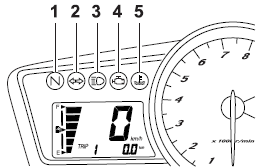Yamaha YZF-R125 Owners Manual: Indicator and warning lights

Indicator and warning lights
- Neutral indicator light"
 "
" - Turn signal indicator light"
 "
" - High beam indicator light"
 "
" - Engine trouble warning light"
 "
" - Coolant temperature warning light"
 "
"
Turn signal indicator light"
 "
"
This indicator light flashes when the turn signal switch is pushed to the left or right.
Neutral indicator light" "
"
This indicator light comes on when the transmission is in the neutral position.
High beam indicator light" "
"
This indicator light comes on when the high beam of the headlight is switched on.
Coolant temperature warning light"
 "
"
This warning light comes on if the engine overheats. If this occurs, stop the engine immediately and allow the engine to cool.
The electrical circuit of the warning light can be checked by turning the key to "ON". The warning light should come on for a few seconds, and then go off. If the warning light does not come on initially when the key is turned to "ON", or if the warning light remains on, have a Yamaha dealer check the electrical circuit.
NOTICE
Do not continue to operate the engine
if it is overheating.
TIP
- For radiator-fan-equipped vehicles, the radiator fan(s) automatically switch on or off according to the coolant temperature in the radiator.
- If the engine overheats, see page 6-38 for further instructions.
Engine trouble warning light" "
"
This warning light flashes or stays on if an electrical circuit monitoring the engine is not working correctly. If this occurs, have a Yamaha dealer check the self-diagnosis system.
The electrical circuit of the warning light can be checked by turning the key to "ON". The warning light should come on for a few seconds, and then go off. If the warning light does not come on initially when the key is turned to "ON", or if the warning light remains on, have a Yamaha dealer check the electrical circuit.
 Main switch/steering lock
Main switch/steering lock
Main switch/steering lock
The main switch/steering lock controls
the ignition and lighting systems, and is
used to lock the steering. The various
positions are described below.
ON
All ele ...
 Tachometer
Tachometer
Tachometer
Tachometer
Tachometer red zone
The electric tachometer allows the rider
to monitor the engine speed and keep it
within the ideal power range.
When the key is turned to "ON ...
Other materials:
Checking the valve seats
The following procedure applies to all of the
valves and valve seats.
1. Eliminate:
Carbon deposits
(from the valve face and valve seat)
2. Check:
Valve seat
Pitting/wear Replace the
cylinder head.
3. Measure:
Valve seat width C "a"
Out of specification Replace
the ...
Removing the generator
1. Remove:
Generator rotor nut "1"
Washer
NOTE:
While holding the generator rotor "2" with the
sheave holder "3", loosen the generator rotor
nut.
Do not allow the sheave holder to touch the
projection on the generator rotor.
2. Remove:
Generator rotor "1"
(with the ...
General tightening torque specifications
This chart specifies tightening torques for standard
fasteners with a standard ISO thread pitch.
Tightening torque specifications for special components
or assemblies are provided for each
chapter of this manual. To avoid warpage, tighten
multi-fastener assemblies in a crisscross pattern
and ...
